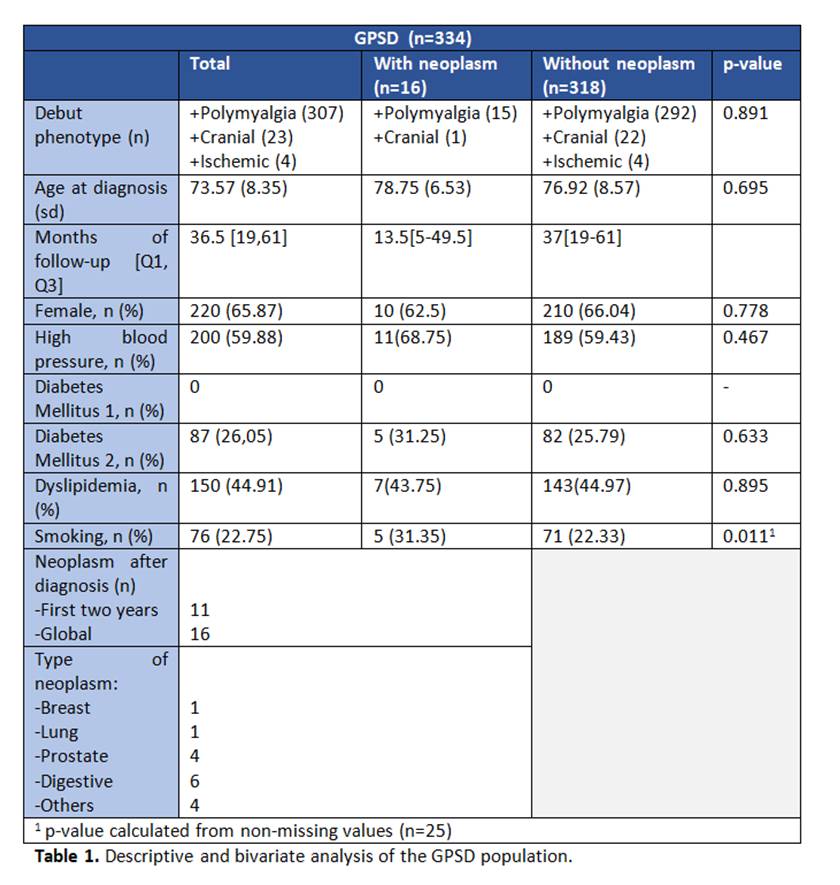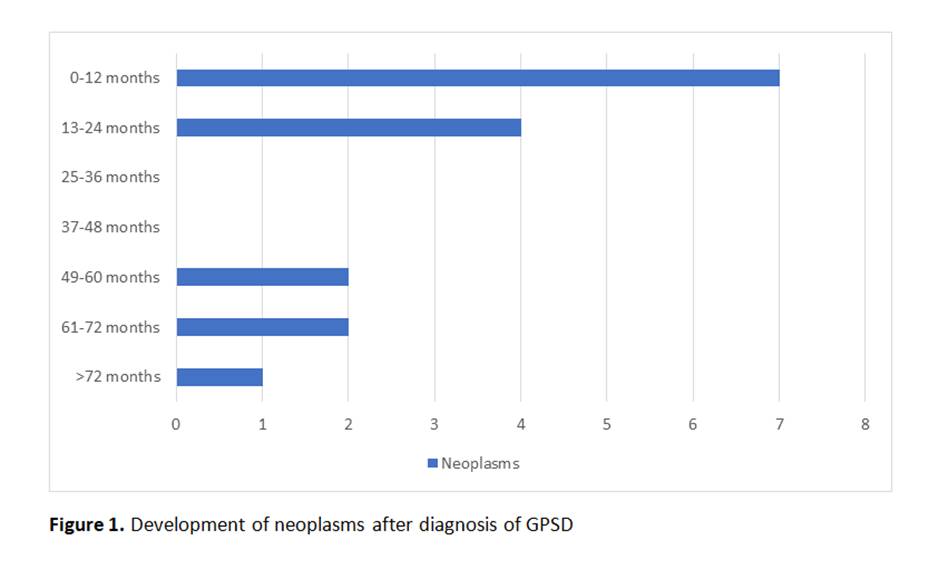Session Information
Date: Sunday, November 17, 2024
Title: Vasculitis – Non-ANCA-Associated & Related Disorders Poster II
Session Type: Poster Session B
Session Time: 10:30AM-12:30PM
Background/Purpose: The dysregulation of the immune system inherent in inflammatory diseases may contribute to the development of neoplasms. However, the relationship between the giant cell arteritis-polymyalgia rheumatica spectrum disease (GPSD) and malignancy is still under debate.
Our aim is to determine the incidence rate of neoplasms among the GPSD population and compare it with the Spanish general population, as well as to identify its role as a paraneoplastic syndrome in terms of temporal criteria.
Methods: An observational, single-center, longitudinal study on GPSD patients (2015-2023) was conducted. Demographic, clinical variables and neoplasms found after GPSD diagnosis (excluding metastatic events or recurrences and non-melanoma skin cancer) were collected. The crude incidence rate of neoplasms in Spain was obtained from the Global Cancer Observatory (GLOBOCAN). In order to adjust by age and sex, we performed an indirect standardization method and calculated the standardized neoplasm ratio (SNR) and standardized incidence ratio (SIR).
Results: A total of 334 GPSD patients were included (66 % women) with a mean age at diagnosis of 73 (8) years old. As a comparative group, we studied the Spanish population older than 50 years old. We found 16 neoplasms in the GPSD group (table 1). The most common types were from digestive system and prostate cancer. Any variable was significantly related with the development of neoplasm after using the bivariate and multivariate analysis.
Out of the 16 neoplasms, 11 (68,75%) were diagnosed within the first two years, specially during the first year (7). The 5 remaining appeared from the fourth year after GPSD diagnosis (figure 1).
The GPSD group showed an incidence rate of neoplasms (IRN) of 1282 (CI 95% 487-2076) per 100,000 person-years (p-y) for women and of 1534 (CI 95% 306-2761) per 100,000 p-y for men.
The SNR was 4.03 (CI 95% 1.53-6.53) in women and 2.37 (CI 95% 0.47-4.27) in men. Considering the neoplasms diagnosed in the two first years, the SNR were 2.42 (CI 95% 0.484-4.356) in women and 2.108 (CI 95% 0.258-3.868) in men (table 2).
The SIR was 3646.75 (CI 95% 1384.85-5908.65) in women and 3547.49 (CI 95% 650.99-6444.29) for men. If we consider the neoplasms diagnosed in the two first years, the SIR was 2189.86 (CI 95% 832.59-3548.13) in women and 3153.99 (CI 95% 394.25-5913.73) in men (table 2).
Conclusion: We observed a high incidence rate of neoplasms in our GPSD patients. For women, incidence was significantly higher than in the general population. For men and neoplasms developed two years after the diagnosis, incidence was higher than in the general population, but the difference was not statistically significant. Most of the neoplasms were diagnosed within the first two years, especially during the first.
To cite this abstract in AMA style:
Muñoz Martínez P, Fernandez Ruiz C, Grau García E, Leal Rodriguez S, Ivorra-Cortés J, Riesco Barcena C, Huaylla Quispe A, Mas Sánchez L, Ramos Castro D, Torrat noves A, Alcantara Alvarez I, Villanueva Mañés B, Simeo Vinaixa M, Pérez Hurtado A, Román-Ivorra J. Giant Cell Arteritis-Polymyalgia Rheumatica Spectrum Disease: Relation with Neoplasms and Role as a Paraneoplastic Syndrome [abstract]. Arthritis Rheumatol. 2024; 76 (suppl 9). https://acrabstracts.org/abstract/giant-cell-arteritis-polymyalgia-rheumatica-spectrum-disease-relation-with-neoplasms-and-role-as-a-paraneoplastic-syndrome/. Accessed .« Back to ACR Convergence 2024
ACR Meeting Abstracts - https://acrabstracts.org/abstract/giant-cell-arteritis-polymyalgia-rheumatica-spectrum-disease-relation-with-neoplasms-and-role-as-a-paraneoplastic-syndrome/



